Using tractor beams to deal with space junk.
In science fiction films, nothing raises tension quite like the good guys' spaceship getting caught in an invisible tractor beam that allows the baddies to slowly reel them in. But what was once only a sci-fi staple could soon become a reality.
Scientists are developing a real-life tractor beam, dubbed an electrostatic tractor. This tractor beam wouldn't suck in helpless starship pilots, however. Instead, it would use electrostatic attraction to nudge hazardous
space junk safely out of Earth orbit.
The stakes are high: With the
commercial space industry booming, the number of satellites in Earth's orbit is forecast to rise sharply. This bonanza of new satellites will eventually wear out and turn the space around Earth into a giant junkyard of debris that could smash into working spacecraft,
plummet to Earth,
pollute our atmosphere with metals and
obscure our view of the cosmos. And, if left unchecked, the growing space junk problem could hobble the booming
space exploration industry,
experts warn.
The science is pretty much there, but the funding is not.
The electrostatic tractor beam could potentially alleviate that problem by safely moving dead satellites far out of Earth orbit, where they would drift harmlessly for eternity.
While the tractor beam wouldn't completely solve the space junk problem, the concept has several advantages over other proposed space debris removal methods, which could make it a valuable tool for tackling the issue, experts told Live Science.
https://www.livescience.com/space/s...d-could-solve-the-major-problem-of-space-junk

